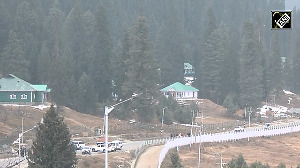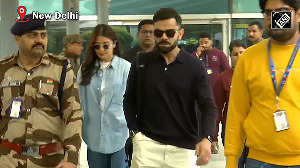On Day 4 of his testimony, Pakistani-American David Coleman Headley outline how the Lashkar-e-Tayiba and the Inter-Services Intelligence wanted to spread terror in India.

Pakistani-American terrorist David Coleman Headley on Friday said Al Qaeda leader Ilyas Kashmiri asked him to recce NationalDefenceCollege in Delhi as it was a primary target for the outfit and that he had also videographed Bhabha Atomic Research Centre and was asked to recruit someone from there to work with ISI.
Headley, who has been testifying before a special Mumbai court in the 26/11 case via video-link from the US since Monday, also revealed that the ISI and LeT wanted to target Mumbai airport and naval station.
He also claimed that he was interested in developing close relations with a Shiv Sena member as he thought LeT would be interested to either attack the Sena Bhawan or assassinate its head.
Headley also said that he never visited the control room in Karachi from where instructions were given to the 10 attackers during the 26/11 terror strikes, in which 166 people were killed and 309 injured.
He identified a photograph of Ajmal Kasab, one of the 10 perpetrators of the attack who was caught alive, when it was shown to him.
Headley told the court that his handlers in the ISI and LeT wanted to target Mumbai airport and Naval air station during the 26/11 terror attack.
“Major Iqbal expressed disapproval of certain areas I had recced as targets. I felt that Major Iqbal was unhappy because Mumbai airport was not selected and included as one of the targets for the 26/11 attack,” said the 55-year-old, who recently turned approver in the case.
Headley said he had videographed BARC at Trombay in Mumbai in July 2008 and that LeT had asked him to recruit some employee of BARC who would work for ISI.
“I also visited and videographed BARC. Major Iqbal told me that in some future date I should recruit some employee of BARC who would give us classified information and would be ready to work for the ISI,” he said, adding that he had handed over the video to Sajid Mir and Major Iqbal.
In further disclosures, he said that after he had recced Mumbai, he had several meetings in Pakistan with LeT leader Zaki-ur-Rehman Lakhvi, Sajid Mir, Abu Kahfa and Abdul Rehman Pasha and Major Iqbal.
He told the court that Al Qaeda leader Ilyas Kashmiri asked him to go to India again as they were also interested in carrying out terror activities in India.
“Ilyas Kashmiri asked me to recce NationalDefenceCollege in Delhi as it was a primary target for Al Qaeda,” he said.
Headley revealed that during his last visit to Mumbai in July 2008, prior to the 26/11 attacks, he had surveyed and videographed the Chabad House in south Mumbai.
“I don’t know who was staying there. Sajid Mir and Pasha asked me to survey this place and said that it was an international location as it had Jewish and Israeli people,” he said.
Headley said he discouraged the LeT about Naval air station and Siddhivinayak temple as targets for the attack.
“I discouraged them (LeT) about Naval air station and Siddhivinayak temple as targets as then all the 10 attackers would have had to concentrate on one target only,” he said.
He said that he tried to develop close relations with a Shiv Sena member as he thought that Lashkar-e-Tayiba might be interested to either attack Sena Bhawan or aassassinate its head”, a reference to Bal Thackeray.
“I met one Rajaram Rege inside Shiv Sena Bhawan in Dadar during 2006-2007. I attempted to develop closer relation with him. I was interested in accessing that building (Shiv Sena Bhawan) at that time.
“I thought LeT would be interested in the future to either attack the Shiv Sena Bhawan or assassinate its head,” he said answering questions put to him by Special Public Prosecutor Ujjwal Nikam regarding all those people in Mumbai with whom he had developed friendly relation.
Continuing to spill beans on the brazen terror attack, he said “for the 26/11 terror attack, LeT handler Sajid Mir and Abu Kahfa, on instructions from Zaki Sahab, decided to go with the stronghold option which means stay put in the place of the target and keep on fighting.”
The second option was to leave the place of target and go to Kashmir and continue fighting with the troops there, he said.
Headley said Kahfa told him that the second option was discarded “as if it was in the mind of the person (attacker) that he has to leave then he will not fight well”.
Headley told the court that Sajid Mir had got the 10 attackers Indian cellphones so that they could guide them during the terror attack.
“I tested one of the phones. Sajid Mir asked me to go to Wagah border if the signal was working in the phone. I did so and informed Sajid Mir that the signals were working,” he said.
Headley also told the court that they got to know from Indian media that one of the 10 terrorists, Ajmal Kasab, was captured after the attack.
“Sajid Mir and everybody in LeT were saddened by this,” he said.
When Nikam showed a photograph of Kasab, Headley identified him and said, “Yes this is Ajmal Kasab... Rehmatullah...this means God bless him or God forgive him.”
When asked about the control room in Karachi from where the LeT handlers were giving instructions to the 10 attackers during the terror attack, Headley said he “never visited the control room and did not meet any other handler, apart from Sajid Mir, Abu Kahfa and Abu-al-Kama”.
He disclosed that during his last visit to Mumbai in July 2008, he had also gone to Siddhivinayak temple and made a video of it.
“I purchased the red and yellow wrist bands.... I forget the name of it. I thought that the 10 youths could wear it as a cover so that people would think they were Indians.
“Nobody asked me to do so. I saw a man selling it outside the temple, so the thought occurred to me. After I returned to Pakistan, I gave those wrist bands to Sajid Mir and explained to him that practising Hindus in India wear this and hence, it would be a good idea if the 10 (attackers) also wear it as it would look like they are Hindus,” he said.
Headley also said that during his last visit, he had purchased five books from a shop at the Taj Hotel.
“During the same visit I also visited the Nalanda book shop inside Taj Hotel where I purchased five books. One of the books was ‘Indian Army Vision 2020’. I was interested to know the progress of the Indian Army in the future,” he said.
When Judge G A Sanap asked Headley why he had purchased the other four books, he said, “The other books were pictorial and beautiful, hence I purchased them. There is nothing sinister about those books. The first book was sinister.”
Headley told the court that he had finalised BadhwarPark in Cuffe Parade as a landing site for the 10 attackers, as the area is covered with shanties and hutments from the main road, and hence he thought it would give tactical advantage to the terrorists.
“In May 2008, I visited US. I could not meet Tahawwur Rana (Headley’s business partner), but I spoke with him on the phone. I said that I had gone to India and selected landing site,” he said.
Headley said that LeT commander Zaki-ur-Rehman wanted to finalise Gateway of India as the landing site for the 10 terrorists as it was very close to the Taj hotel.
“I, however, said it was not a good idea as the attackers would be required to go through Gateway of India by crossing naval installation and they could be detected. Zaki Sahab and others agreed to my suggestion,” he said.
“When Zaki Sahab saw the targets I had selected, he said this was very important and has to be done properly. Zaki Sahab said surveillance for the attacks should be done properly. He said this would give a chance to take revenge for all the bomb blasts India had done in the past in Pakistan. Zaki Sahab wished me good luck,” he said.
He told the court that the idea to divide the 10 terrorists in different groups was also discussed in one of the meetings in Pakistan.
He also told the court that he had informed his first wife Shazia about the 26/11 attack.
“On November 28, 2008, Shazia sent me an e-mail congratulating me for the 26/11 attack,” he said.
Headley is serving a 35-year prison sentence in the US for his role in the Mumbai attacks.










